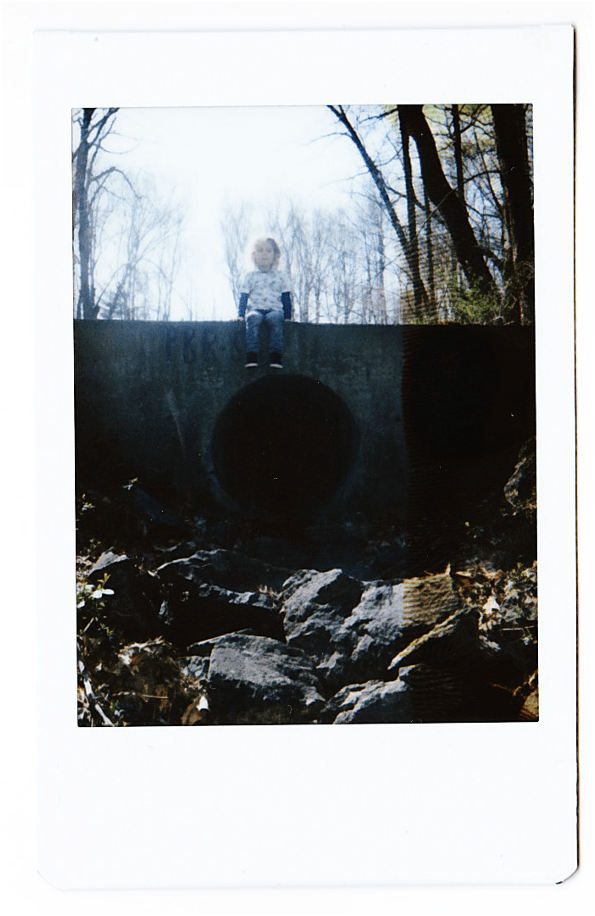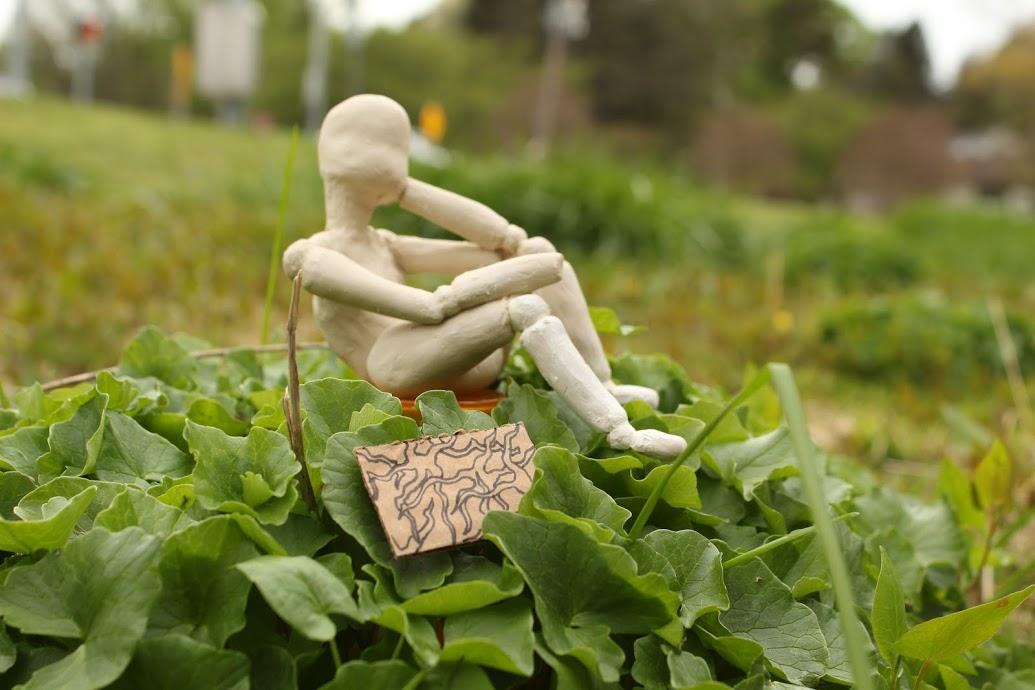Visual artist and lecturer James Westwater guides students through a multi-disciplinary landscape architecture elective course
Untitled (readymade, Skagaströnd, Iceland), 2014, grass, asphalt, dimensions variable
Image Credit: James Westwater, original land art piece
A new advanced course at the University of Maryland (UMD) launched an online exhibition this summer, entitled Spiral Found: Land Art Under Lockdown II. During the spring semester, LARC 689C (Land Art: Interventions, Mediations, Meditations) students from across disciplines prepared land art projects to be shared online through photo gallery exhibits on their personal websites. This two-year young course, led by visual artist and lecturer James Westwater in the Department of Plant Science & Landscape Architecture, guides students from backgrounds across landscape architecture, art, and architecture through an immersive exploration and practice of land art.
But what is land art exactly? Well, in the simplest terms, it is art that is part of, from, or found in interaction with the land. But as Westwater’s syllabus so eloquently states, “Designed land and land art are both subjective constructs of landscape. Fine art practices, including painting, appropriation, found objects, land art, photography, and video, are starting points for students to develop their own visual, critical, and theoretical languages to better communicate, inspire, and lead positive change.”
“The art movement, land art, also known as earth art, kicked off in the late 1960s when a group of New York artists decided to take their work outside of galleries and the city, mostly to Southwestern U.S. states initially,” says Westwater. “Baby steps were quickly followed by giant steps. Much of the early (circa 1970) land art is large in scale, and can involve acres of desert and tons of excavated rock.”
Students explore major influencers and artists in the land art space like Robert Smithson and Michael Heizer, all while producing their own pieces. The trend in recent years, according to Westwater, has been towards photography, video, and conceptual work, with environmental issues coming to the fore of many land art projects. With this in mind, students created conceptual land art pieces throughout the semester, conveyed through photography.
“The eight land art exercises that students of LARC 689C undertake over the course of the semester are designed so that they might experience and share the pleasure of discovery and creation while walking the land,” explains Westwater. “Whether it be through chance encounters with nature; unexpected views, both outward and inward; looking and seeing; with all the senses activated and engaged. Sketchbooks are kept, discussions are had, and students prepare and present their own work.”
As Westwater explains it, environmental ethics also plays a major role in the course and his own work.
“Part of my motivation to create the course was an interest in coming to terms with the ethics (read carbon footprint) of many early, and a few ongoing, earth works, some of which I have visited over the years. My own art practice is modest in scale and rooted in found objects and the studio, but increasingly I find myself walking the land wherever I am and experiencing that as part of my practice. This outdoor, conceptual experience is what I wanted the students to have.”
Student Exhibition: Experiencing Land Art
Here, we feature some of the students from this course and their favorite pieces from the semester. After all, the best way to understand land art is to experience it for yourself.

Danny Bentley, Landscape Architecture graduate student ‘23
“As a landscape architect, this course will forever allow me to see the landscapes I design as an artistic extension of myself and those around me,” says Bentley. “The simple use of organic shapes, lines, and voids can be so effective when conveying a feeling through our works. It is not simply about the flowers you pick for the garden, but also about the sense of place we create for those who will experience the spaces at different stages of their lives.”
Graduating in Spring 2020 with an undergraduate degree from Plant Science & Landscape Architecture in Urban Forestry, Bentley decided to return to the department for a graduate degree in Landscape Architecture. As a musician and artist, Bentley was excited to work with Westwater and learn more about designing for artistic reasons, incorporating both function and beauty in innovative ways.
Much of his work over the semester focused on his son, with particular emphasis on a child’s access to safe natural spaces for growth and development. “We all need a safe space to enjoy the outdoors, and a lot of children don't get that chance, especially during a pandemic,” says Bentley. “I was lucky enough to be able to provide that for my kids and document the process while focusing on the land art pieces for this course. I also love the forest and the healing power of trees. As a forestry major in my undergraduate studies, those spaces are particularly special to me. So, many of my pieces were set in those areas.”
Visit Bentley’s entire gallery on his personal website.

Christian Romero, Architecture graduate student ‘21
“I believe that land in architecture is a form of art that blends the inside and outside seamlessly,” says Romero. “This course has given me an in depth look into the land art scene, and I plan on using it when designing homes, master planning, and landscape architecture in my future work.”
Romero’s work is spiritual in nature, with each piece represented by a quote from scripture. “My work is focused on the individual and their own perception of spiritualism. It is important to bring these topics up and not shy from ‘difficult’ topics.”
Through this course, Romero was able to play with scale and learn more about the different sizes and impacts land art can have. For example, his piece entitled Psalm 103:6 is located at Riversdale Mansion in Riverdale, Md. This piece places the audience in a direct view of or away from history, present and future. This piece is meant to personify disparity.
Visit Romero’s entire gallery on his personal website.

Emily Garcia, Art Education and Studio Art undergraduate student ‘23
“With this course, I felt as though each exercise was a way to reconnect with nature, the environment around me, and to myself,” says Garcia. “I believe that the experience and that sensation of a reconnection was most impactful because of the effects of the pandemic. I’ve always admired nature and often find myself capturing it’s beauty through photography. Land Art was another opportunity to get closer to nature and a different way of creating art.”
As the only undergraduate student in the course, Garcia was looking to expand her experiences and knowledge as an art major. In the open and nurturing environment created by Westwater, Garcia says he was able to learn to listen, be more aware, and express her emotions through her work.
“I found myself becoming more open with sharing my experiences,” shares Garcia. “The last few exercises, I decided to open up about and make connections to my recent diagnosis. I wanted to create awareness for fibromyalgia. In a way, it was also my way of accepting my diagnosis. Art has always been an outlet for self expression and a way of coping with anything and everything I am going through.”
Visit Garcia’s entire gallery on her personal website.

Martin Esteban Gonzales, Fine Art graduate student ‘22
“Honestly, this course has completely changed my practice as an artist,” says Gonzales. “I know that is a bold claim to make, but it has. Dr. Westwater is an impassioned educator and a real human being. His candidness and knowledge of Land Art made critique of our own art insightful and helpful.”
As an art major, Gonzales has expressed feeling constrained by the academic environment. This feeling is similar to the “itch” the pioneers of land art felt to get their work out of the confines of a studio and into more expansive spaces. “Land art is about the expanded field, and the gallery and studio is just a facet of all that is possible,” he says.
According to Gonzales, the artwork he appreciates most is work that pushes the boundaries of any particular medium. So, when given the assignment to create a monolith, he created this “seemingly floating 9 foot monolith,” he says. Conceptually, this piece is about not asking permission to be and express yourself, while giving space and nature the proper reverence it deserves. “If I’m not hurting anyone with my expression, it should be unequivocally accepted that you and I be granted to ‘say’ what’s on our hearts or minds with respect,” says Gonzales. “Moving forward, I am to listen deeper to the ecosystems and spaces I’m in and ask them for permission. That makes sense to me.”
Visit Gonzales’ entire gallery on his Instagram.
Find links to all the student's work and online galleries here: https://linktr.ee/LandArtUMD